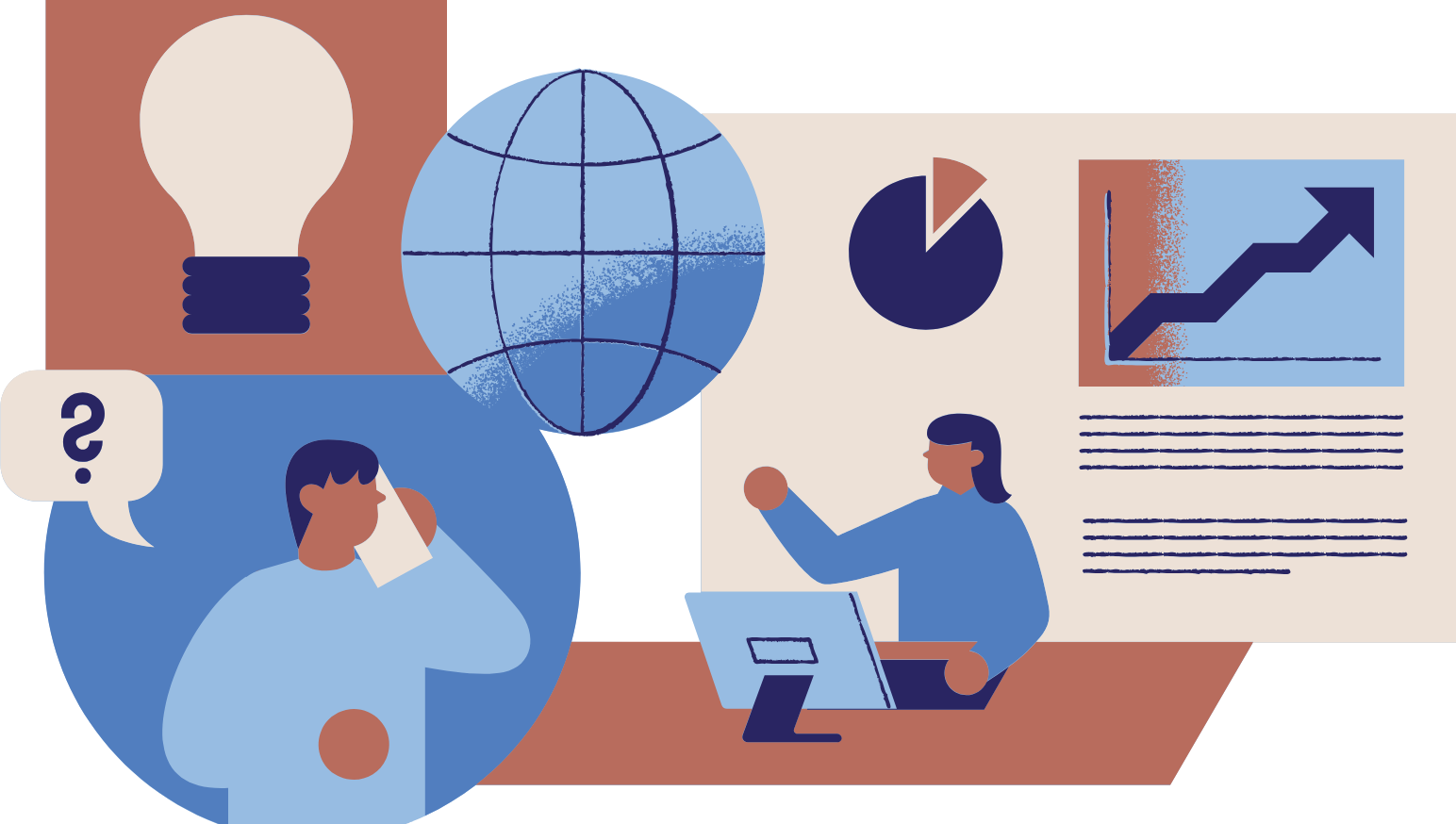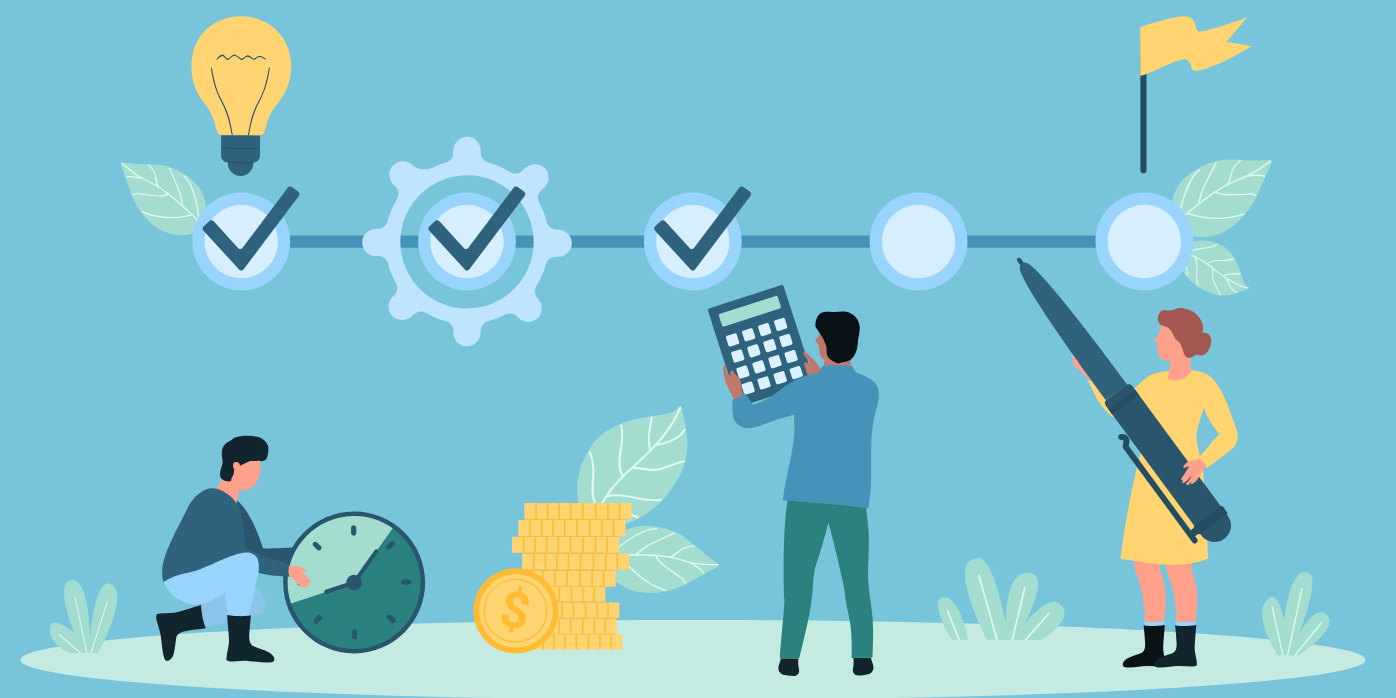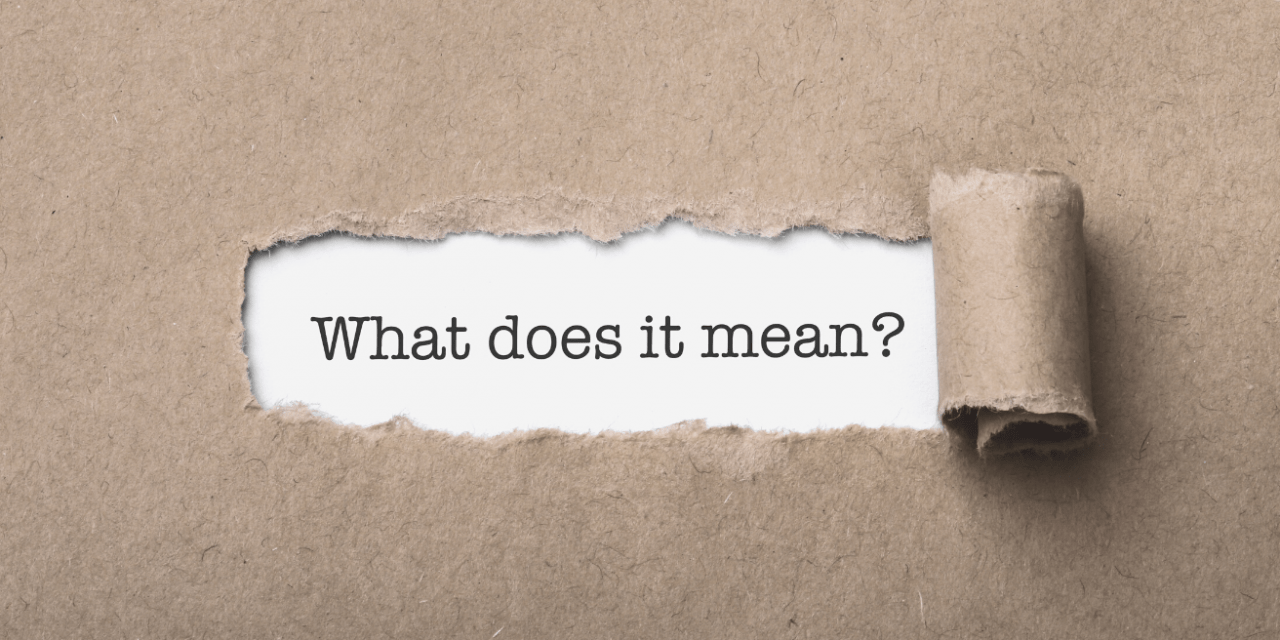ONE PARTNERSHIP’S EXPERIENCE IN SUPPORTING RPP LEARNING & PARTNERSHIP DEVELOPMENT THROUGH THE NNERPP ANNUAL FORUM

INTRODUCTION
This past July, we held our seventh NNERPP Annual Forum, our yearly gathering of NNERPP members and friends in the research-practice partnership (RPP) space to come together and learn about all-things-RPP. The Forum’s main purpose is to provide shared learning opportunities across attendees in order to continue cultivating our collective knowledge of how to do RPP work. Sessions are organized around critical topics that have emerged from our members’ experiences; these include, for example, discussions featuring real-life examples of how equity shows up in RPPs, workshopping around the nuts and bolts of RPPs, and more philosophical conversations around what is or is not an RPP. NNERPP members not only attend but also lead sessions and present at the Forum. Over the last three years we’ve offered a virtual Forum, which has allowed us to invite our members to “bring” up to 20 people from their partnership to attend. Most have taken us up on that offer and thus, we’ve had robust participation in the meeting from many people who might not be able to attend an in-person Forum.
Although the Forum is a great place to hear, talk, and learn about a wide variety of RPP models, promising practices, and successes, we stop short of referring to it as a formal “professional development” opportunity, even though it could certainly be considered that. The main reason for this is our intentional preference for how learning takes place, i.e., it is left entirely up to attendees (as opposed to us requiring or outlining how learning should occur). To that end, we work with the NNERPP Steering Committee to pick and organize sessions that are likely to be relevant and useful to our members and the field, but how participants engage in those learning opportunities, and to what extent, is completely self-directed. This allows members to adopt a “take what we need” approach to their learning and make choices about how to utilize the opportunities at the Forum that best suit their context. Accordingly, there is a wide range in how members engage in the Forum, with some teams building their own internally driven professional development experiences centered around the Forum, while others send a few key informants that will then report back to the full RPP team on various ideas that might be relevant, to everything in between.
In this Deep Dive, we will hear from the Madison Education Partnership (MEP), which is an RPP based in Madison, Wisconsin and features a collaboration between the Madison Metropolitan School District (MMSD) and the University of Wisconsin-Madison (UW-Madison) Wisconsin Center for Education Research. Following this year’s Forum, two of the MMSD leaders of MEP – Bri Monahan and Beth Vaade – shared their approach to partnership learning, which involved using the Annual Forum as an anchor for that learning. This led to a number of interesting (and sometimes unanticipated!) insights for the MEP team, which the team shares below in hopes that others might draw inspiration from their efforts in designing their own partnership learning opportunities. We also think MEP’s experiences might be useful for the RPP sector more generally, especially as we continue to conceptualize partnership work as one that occurs at the “boundaries of research and practice.” In particular, we highlight below how the NNERPP Annual Forum ended up serving as a “boundary practice” that helped bring together members of both the “R” and “P” sides into a “third space” that might otherwise not have occurred. These types of “boundary crossing” activities are key to building and strengthening relationships across “R” and “P”, which is fundamental to partnership work.
PART 1: OVERVIEW OF THE MEP LEARNING OPPORTUNITY FROM BETH & BRI ON THE MEP TEAM
During the 2021-22 school year, we as the practice-side leaders of our RPP set out to strengthen the working relationship between our UW-Madison based MEP staff (4 total) and the district’s Institutional Research & Evaluation (IRE) team (7 total). While these two teams knew each other and had worked together in the past, we believed we could build a stronger relationship between them that would lead to more collaborative, rewarding, and engaged research. We tested out a new way of working by implementing a biweekly team connection, where we met for an hour in-person and on Zoom to share projects, give feedback, and get to know each other. We also identified the NNERPP Annual Forum as a opportunity for shared professional development around RPPs. We asked both teams (UW-Madison and MMSD) to sign up for Annual Forum sessions and to attend two internal meetings – one prior to the Forum to calibrate and prepare and one after the Forum to debrief and share. We believed the Annual Forum would provide an opportunity for a shared learning experience across teams, where neither team were experts and both brought important perspectives to the table. We also knew we needed some structure to the experience to ensure that it wasn’t just an individual opportunity, but a chance to further our shared goal of strengthening relationships between IRE and UW-Madison MEP staff.
In practical terms, here’s what we set up:
- One 60 minute pre-meeting one week prior to the Forum: We offered this as a hybrid meeting (both in-person and on Zoom) and scheduled it during our regular biweekly team connection. We structured and facilitated the meeting, which focused on three main topics: 1) completing a spreadsheet where each member identified which sessions they would attend at the Annual Forum; 2) creating shared commitments for our combined team on how we would communicate these learnings (e.g., Slack conversations for those attending the same session; a document where you would post 1-3 key takeaways from each session you attend); and 3) giving time for those who had previously attended the Annual Forum to share tips and tricks, and those new to the Annual Forum to ask questions. We captured all these learnings on a Jamboard and in Google Sheets.
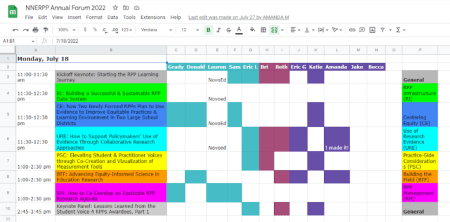
Artifact 1: Spreadsheet identifying which sessions each member would attend.
- One 60 minute post-meeting one week after the Forum: We again offered this as a hybrid meeting and scheduled it during our regular biweekly team connection. We structured and facilitated the meeting, which focused on three main topics: 1) sharing the best sessions we attended and the top lesson we learned; 2) debriefing on the experience (e.g., how did it go for you, what feedback would you give NNERPP); and 3) identifying actionable takeaways we can use for the coming year’s work together. We captured all these learnings on a Jamboard and in Google Sheets.
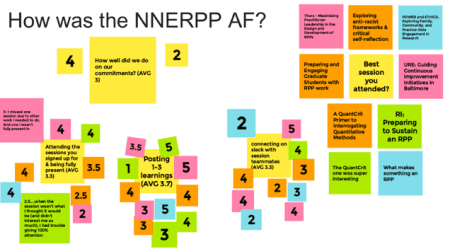
Artifact 2: Jamboard answering the questions: “How well did we do on our commitments?” and “Best session you attended?”
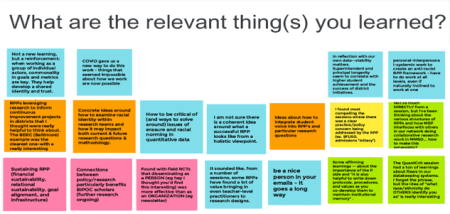
Artifact 3: Jamboard answering the question: “What are the relevant thing(s) you learned?”
PART 2: LESSONS LEARNED BY MEP LEADERS
Our MEP Lesson #1 – The NNERPP Annual Forum can serve as a boundary practice
Through this experience, we learned a lot about how to broker relationships and leverage professional learning opportunities like the Annual Forum. The pre-meeting helped us effectively set up systems to attend and engage in the Forum collectively. We connected with each other in advance, figured out which sessions others were interested in (and shifted our own preferences at times based on what others selected), and created systems to ensure we held each other accountable to participate fully.
While those actions helped, we faced some surprising hurdles in reaching our overarching goal of strengthening the relationship between the two teams through this pre-meeting. Because most of the UW MEP team had attended the Annual Forum previously and most of IRE had not, our conversations to prepare for the Forum unintentionally set up MEP as “experts” and IRE as “newbies” to the work. In reflecting on that meeting, we noticed after the fact that dynamic fed into some of the historical relationship concerns, where MEP faculty as researchers show up with more power and autonomy while IRE as practitioners feel less powerful and more treated as on-demand support. In an effort to be helpful and share their experience (and excitement around how great they thought the Annual Forum could be for everyone), our MEP teammates made it feel like IRE was entering “their space” at NNERPP.
The post-meeting dynamic, however, had a very different feel. We still accomplished our goals of checking in on our commitments, sharing key learnings, and debriefing on the experience as a whole. But since the conversation focused on the Annual Forum experience itself (an activity which everyone now had in common), we found that it leveled the playing field in terms of who was an “expert.” When we broke down the experience (e.g., who enjoyed it, who struggled to find value in particular sessions), we found that it crossed team lines (as opposed to our pre-meeting, where MEP team members were aligned in their experiences of the Forum, separate from the IRE team). This led to a more interesting, dynamic, and inclusive discussion across the whole group. Through that conversation, we came together more as a collaborative group, rather than as individual teams, which aligned with our overall goal of trying to strengthen our relationship and shared trust.
NNERPP’s Reflections on Lesson #1: Annual Forum as a boundary practice
As we alluded to in the Introduction, the MEP team’s experience of intentionally planning partnership learning that used the NNERPP Annual Forum as an anchor ended up resulting in a meaningful exchange across the two organizations, one that might not have occurred otherwise. We think this is a great example of a boundary practice, defined as “partnership activities that bring together multiple participants with varying roles, perspectives, experiences, and areas of expertise, and who are situated within organizations with different capacities and conditions” (Farrell, et al., 2022, p. 3). Boundary practices are essential to supporting the necessary joint work that takes place in RPPs, particularly because they enable “in-between and hybrid activity systems” to occur (Penuel, et al., 2015, p. 190). As Beth and Bri described above, the joint experience of participating in the Annual Forum together enabled the “R” and “P” teams of the partnership to collaborate on a level playing field that is not typically an inherent feature of RPP work.
Although we have not previously thought of the Annual Forum as a boundary practice, it is unsurprising to re-interpret its potential in facilitating partnership learning in this way. We intentionally design the Forum to be a non-research based gathering (i.e., not a “conference”) where members and friends of the network are invited to explore all aspects of partnership work. Given this implicit hybridity, the Forum provides a nice platform for RPP teams to break through their own organizational boundaries and experience something together – these are indeed the defining characteristics of a boundary practice. From MEP’s story shared above, it was especially interesting to see the evolution of the team’s discussions and cohesion as a result of participating in the Forum: before, there were distinct lines or boundaries based on organizational home that kept the team from truly feeling “as one”; and after experiencing the Forum together, the teams saw a blurring of their organizational boundaries and found synergy across “R” and “P” lines, which is (again) a critical feature of truly engaging in “joint work”.
We share this particular example to hopefully spark conversations among other RPP teams – there are an infinite number of boundary practices one could design in service of supporting the kinds of “boundary crossing” similar to what we described here. Many of these are likely to be internally designed, such as co-writing a synthesis of partnership work that will be presented at a conference, for example. This case is interesting in that the team took advantage of an opportunity that was created externally to them, and leads us to wonder, what kinds of additional boundary practice opportunities could NNERPP design and offer for teams?
Our MEP Lesson #2 – Building “togetherness” may require an emphasis on group-level choices
The experience of having our teammates choose which sessions to attend (with no guidance in advance or requirements that MEP and IRE cover all Annual Forum sessions) gave us interesting insights into how people see their work and role within the RPP. Some teammates gravitated to sessions focused on “Building the Field”, while others worked almost exclusively in the “Centering Equity” or “Use of Research Evidence” strands. While a few teammates valued opportunities to connect with others in NNERPP through “Sparklers” and networking, most skipped those sessions, instead opting for content-focused opportunities over those that prioritized relationship-building. As we learned in our debrief at the post-Forum team meeting, whether someone felt a session was useful depended both on their personal interests and in how they saw themselves involved in our RPP or RPPs more generally.
This experience has left us with some key questions as we build out our RPP. If we believe shared learning can be a high-leverage strategy to strengthen relationships and our RPP, then how do we navigate the diversity of preferences in shared learning? Do we honor the desire for individuals to determine their own learning experiences or do we adopt a commitment to pushing out of our comfort zones so that we can truly have a shared experience (or boundary practice) that helps solidify our “togetherness”? In this instance, we really let individuals choose their own adventure at the Forum, but that meant we tended to work inside our comfort zones. Perhaps that’s ok, if the diversity of our team means that collectively we had a rich experience. But perhaps we could have done more to push each other to work in new and different ways, which can be what makes an RPP great.
NNERPP’s Reflection on Lesson #2: Building “togetherness” may require an emphasis on group-level choices
From the Farrell, et al. paper: “…boundary practices can establish roles, responsibilities, and expectations that clarify what is expected of participants and how they can contribute to the activity as a whole (Davidson & Penuel, 2019)” (p. 3). Staying with this idea of boundary practices, we can see that the Annual Forum did enable the MEP team to do exactly this, i.e., establish “roles, responsibilities, and expectations” around their participation in the Forum, with the aim of supporting shared learning. What is so fascinating about MEP’s second reflection though, is that they are highlighting a deeper nuance to this potential than what is implied in the description offered in the paper, especially as it relates to strengthening partnership. That is, how one defines what the “roles, responsibilities, and expectations” are with respect to participation in the boundary practice may either support greater individualistic participation in the activity or may lead to a greater sense of what Beth and Bri call “togetherness” (or what I might call “partnership identity”). In MEP’s case, while the Forum itself clearly led to a terrific instance of shared learning across the R and P boundaries for the team (e.g., see Lesson #1), their approach to assigning “roles, responsibilities, and expectations”, wherein they left it up to each team member to decide what sessions to attend, may have lessened the degree to which the team worked towards a “partnership identity”.
Why does this matter? We can think of partnership identity as a “third space”, i.e., not existing in the “R” or “P” sides exclusively but in the middle of, say, a Venn diagram of both of those spaces. This space might be very important for creating deeper commitments to the work, for example, since it invites all members of the partnership to see themselves as part of a unified team. In the case shared here, while MEP was able to transcend boundaries through joint participation in the Forum (evidenced by the post-Forum discussion shared in Lesson #1), the team did not necessarily work intentionally to deepen the shared cultural boundary that makes up “MEP”. Thus, allowing everyone to “choose their own adventure” rather than setting forth a set of shared learning goals that each team member would work towards via the Forum seemed to have lessened the team’s opportunity to build a shared cultural boundary.
It’s not clear which way, i.e., enabling individualistic growth versus team “togetherness”, is “better” as it likely depends on a number of factors, including where the partnership is in terms of development, age, commitments, trust, etc. One can certainly imagine a team purposefully using the Forum to create a shared learning experience that would still honor the individual preferences of the team, as what MEP ultimately chose to do. Or, using the Forum to help work towards a partnership identity and thereby inviting folks to strategically participate in particular sessions that would advance that aim. And it could also be that both are important – sometimes it makes sense to pursue individualistic goals, while other times it might make sense to work towards shared identity. Regardless, the takeaway reflection here seems to be, while boundary practices are likely critical for encouraging joint work in RPPs, the more micro-level details of how folks participate in that boundary practice may have different implications for advancing a partnership identity.
Our MEP Lesson #3 – The Annual Forum surfaced a larger partnership question, How big is our tent?
For the Annual Forum, we opened up participation to more people than we would otherwise have if it was in-person. This step towards a “bigger MEP tent” has also lifted up a question that had been brewing throughout the year, as we brought our teams together more intentionally to build relationships. Is MEP made up only of the core staff, who then works with the district IRE team on RPP projects, or is MEP ultimately made up of any MMSD or UW staff who are working on a MEP project? This distinction may seem like semantics, but we think it’s actually a key definitional issue that structures how we will work together and the way we show up in the work. It shifts the frame to say “I am working with MEP” versus “I am MEP and represent MEP.” How does our team understand and determine this frame? Who gets to make this decision of who is MEP and who is not? These questions also intersect with ideas about how we use the learnings from an experience like the Annual Forum. While everyone can choose a session to attend, they may not always feel like they have the authority or power to implement that new knowledge within our RPP.
These questions become even more complicated as we widen the frame beyond the two core teams mentioned here to other MEP collaborators. This year, we focused on creating systems and structure for shared learning between these 12 people, as part of the ongoing line of work and because we supervise and have authority to ask/require those people to attend. But we also invited an additional 8 MEP collaborators to participate in the Annual Forum, including MMSD and UW colleagues working on other projects. They did not engage in this learning experience the way we did, instead attending independently. We’d be curious to debrief with them about how they see themselves in MEP, how they represented us at the Annual Forum and whether they’d be interested in participating in an experience like this next year. We also know that if the Annual Forum returns to in-person (as we hope it will), we could not send all of the 12 folks from this past year to attend. Who will get to go? How do we decide? How do we create shared learning when the attendee list contracts? These are all outstanding questions for us.
NNERPP Reflection on Lesson #3: How big is your tent?
Beth and Bri’s Lesson #3 has clear connectivity to the previous two lessons we shared and builds especially on the previous insight, where we introduced the idea of partnership “togetherness” or “identity”. In this case, though, Beth and Bri thoughtfully highlight perhaps an even trickier question than the “how” are we building partnership identity we explored in the last section to ask “but, who??”
At first glance, the idea of “who” is involved in the work may seem rather straightforward. Afterall, there are likely a set of core partners that consistently meet together to collaboratively define and lead the RPP’s work. For example, there are instances where the “who” who needs to show up may be obvious, such as named leadership engaging in an annual meeting to revisit the partnership’s overarching mission and vision. But this question of “who” becomes less clear once the activity itself is less defined and / or consists of a boundary practice that is already hybrid in nature, such as the Annual Forum.
Incidentally, this is an enduring question that we have grappled with at NNERPP since its inception. In our case, membership in NNERPP is currently limited to RPPs, e.g., those occupying the “third space” we talked about earlier, and thus, we define the “who” at an organizational level. As a result, we have avoided the question of “who” and have instead left it up to the RPPs themselves to decide who from their team should participate across the various activities offered by NNERPP. This question became increasingly more visible over the last three years as we shifted the NNERPP Annual Forum to a virtual event. Because of this feature, we were able to encourage all of our members to “send” up to 20 members of their team to participate. This was a large departure from the in-person versions of previous Forums, where teams were only able to send one R-side and one P-side representative to attend on the RPP’s behalf. It was quite interesting from our end to see just who was nominated to attend on a partnership’s behalf, since we had only been engaging with a much smaller number of partnership members pre-pandemic.
And therein lies the challenge Beth and Bri are describing: Given the opportunity to participate in less clearly defined partnership activities (such as the Forum), MEP needed to make some calls about who from the team would attend. A number of related questions here include: How deep is the RPP’s bench? What implications does this have for the work? For partnership identity? Furthermore, will an RPP be stronger if it has more partnership members that identify as an “RPP-er” of that particular RPP? Of the field more broadly? (In some sense, it seems as though yes, it certainly couldn’t hurt, since we already know that sustainability of RPPs depends on planning for turnover [which will happen] and cultivating multiple champions for the work). But of course, this kind of deeper relational investment in strengthening the partnership’s identity is not without cost, as it calls upon existing core members to build and deepen connective tissue with more and more individuals (and maybe even more organizations?). Someone (or someones) will need to shepherd this spreading of tissue, and depending on the initial size of the partnership or the proposed work, it may be a challenge to do well. And let us not forget that all of this is in service to a “third space” that is essentially invisible, as it does not exist in the same way that a brick and mortar organization, i.e., the ones making up the partnership, does.
PART 3: CONCLUDING THOUGHTS, ENDURING QUESTIONS
So, what does this all mean for the work? For the broader RPP space, this reflection piece shows the potential that boundary practices can have in supporting partnership learning, which may help strengthen how members of a partnership relate to each other. In addition, boundary practices can be used to both reinforce individual identities within a partnership or to further develop the partnership’s group identity. Because there isn’t a “default” mode of learning for these, RPPs will need to intentionally take this into consideration as they integrate boundary practices into their work.
Finally, the challenge of identifying “who” is considered core to the partnership and who might be a member in a more extended capacity requires careful attention, especially because the boundaries of these identities may change depending on a given partnership activity. We recommend mapping out the various organizations considered members of the RPP and then detailing which staff members are considered part of the partnership, including placement of how central they may be to decision making on RPP direction and leadership. An activity like that may help create a shared understanding across partners of the “who” is involved in the work. It might be that this map changes depending on the partnership activity, but it can at least be a starting point. A map like this might even be considered a “boundary object” – “material and conceptual tools used in a partnership that are critical for joint activity” (Farrell, et al., 2022, p. 3).
We hope the lessons and insights shared here can be useful to other partnerships as they ponder how to support RPP learning. And we are so excited to follow along MEP’s learning journey and see where they go next!
Beth Vaade is Executive Director of Research & Innovation at Madison Metropolitan School District and Co-Director of the Madison Education Partnership; Bri Monahan is the Research Director at Madison Metropolitan School District and Deputy Director of the Madison Education Partnership; and Paula Arce-Trigatti is Director of the National Network of Education Research-Practice Partnerships (NNERPP).
Suggested citation: Vaade, B., Monahan, B., & Arce-Trigatti, P. (2022). One Partnership’s Experience in Supporting RPP Learning & Partnership Development Through the NNERPP Annual Forum. NNERPP Extra, 4(3), 8-15. https://doi.org/10.25613/JWVH-M560
